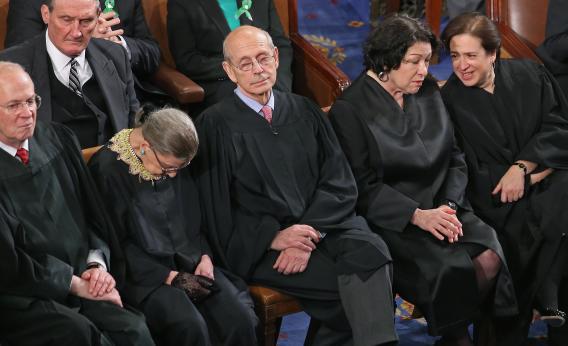What do Supreme Court justices Sonia Sotomayor, Ruth Bader Ginsburg, and Elena Kagan have in common? As Adam Liptak explains in The New York Times this week, it’s definitely not that they are all women! “Three Justices Bound by Beliefs, Not Just Gender,” the story is titled. “The justices are notable for how often they agree with each other,” reads the caption beneath a snapshot of the trio. “The alignments are a product of ideology, not biology,” Liptak writes.
Liptak is correct: Kagan, Sotomayor, and Ginsburg agree with each other in over 93 percent of their decisions, and their agreement cannot be explained by synced menstrual cycles. But do we really have to write that insight down and publish it in a newspaper? The more Liptak works to debunk the idea that these women agree just because they’re women, the further he reinforces the gender stereotype. After all, the ladies of the high court aren’t the only ones who tend to concur. John Roberts and Samuel Alito agree in 90 percent of cases—they are, you could say, two justices bound by beliefs, not just gender. Stephen Breyer and Elena Kagan decide together 91 percent of the time—two justices bound by beliefs, and yet, not gender! It’s almost as if Liptak arbitrarily set the boundaries for his trend story based on biology, not ideology.
There is a vaguely relevant point to be made about these justices’ ideological and gender alignment: It highlights the fact that in recent administrations, Democratic presidents have been more committed to appointing women to the court than Republican presidents. So far, President Obama has successfully nominated two women to the court; after his nomination of Harriet Miers failed to gain traction in 2005, President Bush nominated two guys. Liptak doesn’t dive into any of the cultural implications of that lopsided commitment to gender diversity. Instead, he takes a meandering tour of what three of the nine justices do in their free time. When these women aren’t on the bench, no one would be surprised to learn, they have different personal hobbies and make separate public appearances: Sotomayor was on Sesame Street; Ginsburg collected a $2,500 swag bag from Glamour; Kagan shot and killed a deer. No, these women are not simply interchangeable representatives of their gender. But busting a stereotype that never existed only stirs up the perception that there was something to it in the first place.
